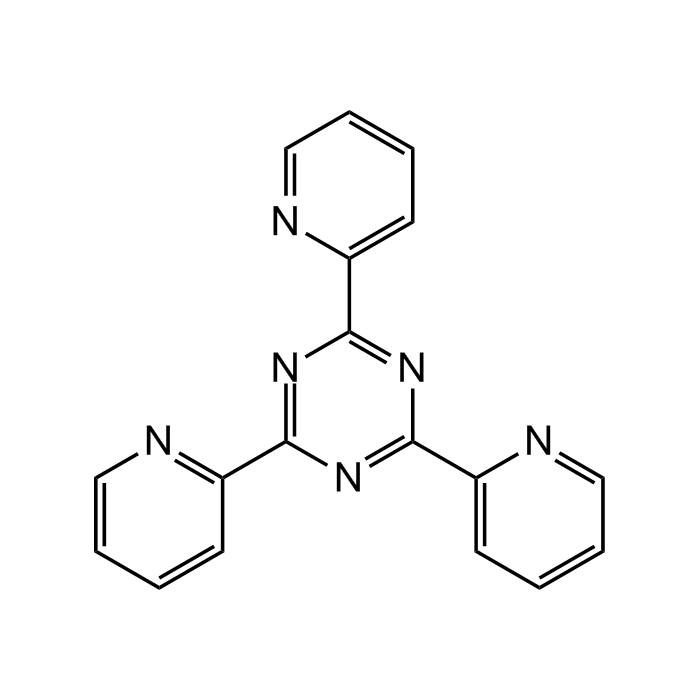Cookie Policy: This site uses cookies to improve your experience. You can find out more about our use of cookies in our Privacy Policy. By continuing to browse this site you agree to our use of cookies.
Chemodex
2,4,6-Tris(2-pyridyl)-s-triazine

| Product Details | |
|---|---|
| Synonyms | 2,4,6-Tri(2-pyridyl)-s-triazine; TPTZ; NSC 112125 |
| Product Type | Chemical |
| Properties | |
| Formula | C18H12N6 |
| MW | 312.33 |
| CAS | 3682-35-7 |
| Source/Host Chemicals | Synthetic |
| Purity Chemicals | ≥99% (UV) |
| Appearance | Off-white to pale yellow powder. |
| Solubility | Soluble in DMSO, ethanol or methanol (10mg/ml). |
| Identity | Determined by 1H-NMR. |
| Declaration | Manufactured by Chemodex. |
| Other Product Data |
Click here for Original Manufacturer Product Datasheet |
| InChi Key | KMVWNDHKTPHDMT-UHFFFAOYSA-N |
| Smiles | C1(C2=NC=CC=C2)=NC(C3=CC=CC=N3)=NC(C4=CC=CC=N4)=N1 |
| Shipping and Handling | |
| Shipping | AMBIENT |
| Short Term Storage | +20°C |
| Long Term Storage | +20°C |
| Handling Advice | Protect from light and moisture. |
| Use/Stability | Stable for at least 2 years after receipt when stored at RT. |
| Documents | |
| Product Specification Sheet | |
| Datasheet |
 Download PDF Download PDF |
2,4,6-Tris(2-pyridyl)-s-triazine (TPTZ) is commonly used as a complexing reagent used in spectrophotometric analysis, particularly in the determination of iron(II) (ferrous) ions in solution. It forms a blue-colored complex with ferrous ions, which can be quantified using spectrophotometric methods. TPTZ forms a complex with Fe(II) that can be quantified by colorimetric detection at 594 nm as a measure of iron concentration. The formation of this complex is the basis of the ferrous ion assay known as the Ferrozine method. Its sensitivity and specificity for iron make it a valuable tool in analytical laboratories. TPTZ has several other applications. TPTZ can be used as a chemosensor for detecting metal ions. Its ability to form colored complexes with different metal ions can be exploited in developing sensors for metal ion detection in solution. TPTZ and related compounds have interesting photophysical properties, making them potentially useful in photoluminescent materials and optoelectronic devices. TPTZ can act as a bridging ligand to form coordination polymers with metal ions. These coordination polymers often possess intriguing structural and functional properties, making them interesting for materials science and nanotechnology applications. TPTZ can be used for monitoring and assessing metal ion concentrations in environmental samples, such as water and soil, to study environmental contamination and metal ion mobility. Apart from iron determination, TPTZ has been explored for the determination of other metal ions, including copper, zinc, cobalt, nickel, and others, using spectrophotometric or fluorometric methods.
(1) P.F. Collins & H. Diehl; Anal. Chem. 31, 1862 (1959) | (2) G. Nakagawa & H Wada; Talanta 20, 829 (1973) | (3) A. Samadi-Maybodi, et al.; Spectrochim. Acta A Mol. Biomol. Spectrosc. 136, 832 (2015) | (4) Z. Dehghani, et al.; Anal. Bioanal. Chem. Res. 2, 13 (2015) | (5) Z.-X. Wang, et al.; Luminescence 30, 835 (2015) | (6) J. Kang, et al.; Luminescence 30, 1360 (2015) | (7) L. Klepo, et al.; Molecules 21, E101 (2016) | (8) S.E. Dominquez, et al.; Dalton Trans. 49, 12742 (2020) | (9) Y. Zhao, et al.; ChemistryOpen 12, e202200176 (2023) | (10) L. Wang & Y. Wang; J. Forensic. Sci. 68, 1317 (2023) | (11) S. Pramanik, et al.; Inorg. Chem. 62, 7220 (2023)





